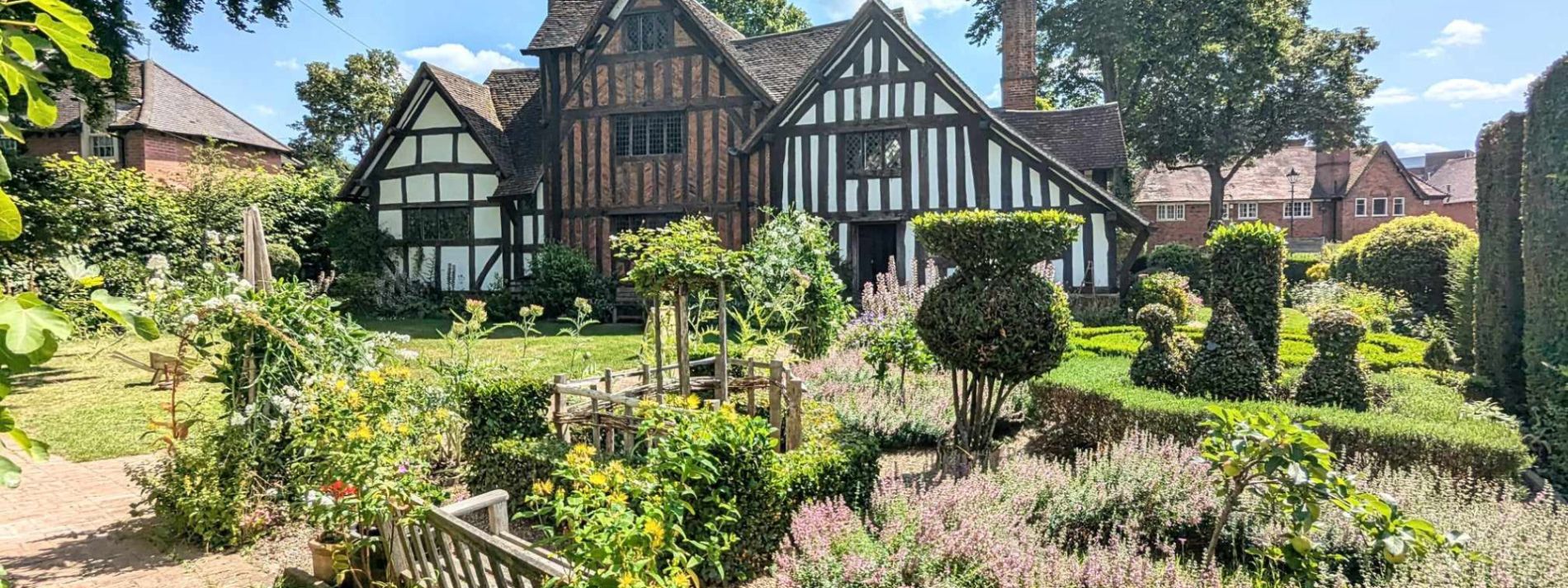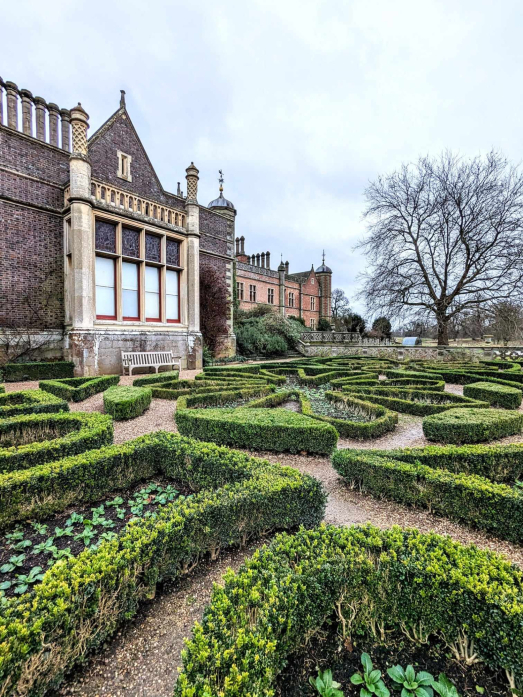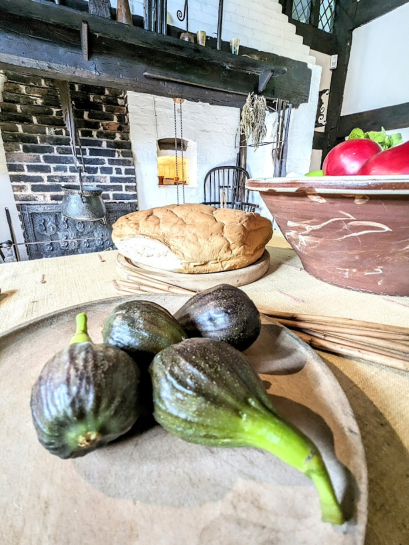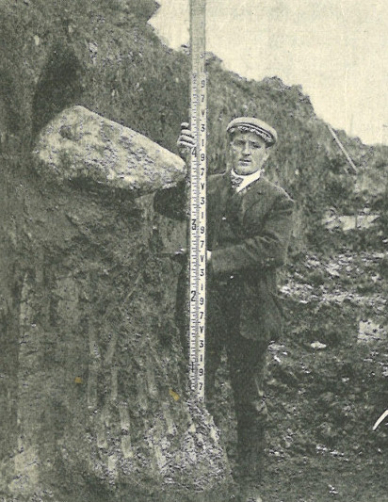
In this section
Featuring a box parterre, perennial herbaceous border, fruit and vegetable beds, a medicinal and culinary herb bed, a wildflower garden and espaliered fruit trees, the Selly Manor garden is a great place to sit and relax.
In this section you will find more information about the Selly Manor garden. During your visit there are 7 boards in the garden which are designed to guide you through the plants and features.
The information below provides further detail.
The Parterre
Ornamental gardens were a symbol of status. The development of theories of architecture and design in Italy in the 15th century influenced the kings and nobles of the next generation to take a personal interest in design, layout, and planting.
The finest Tudor gardens were created by King Henry VIII and Queen Elizabeth I. Henry spared no expense at Whitehall Palace, Hampton Court Palace and Nonsuch Park. He spent time and money on his gardens, strolling through with his wife or daughter Mary. Admiring gardens became fashionable and courtiers would share tips and seeds.

Image: Charlecote Park
The Tudor age loved order and structure the signature knot garden, where everything is in its place, reflects the culture of bending nature to useful production and the garden as a symbol of control and purity in a wild and disordered world.
Knot gardens were first created in the 1550s during the reign of Elizabeth I. Knots were usually small and had various height levels at hedge junctions to indicate the crossing of threads. They were filled with gravel or mulch. They were planted with evergreen hedging and herbs such as lavender, rosemary, thyme, hyssop, and golden marjoram to give form, texture, and a variety of leaf colour, creating the embroidered look.
The Kitchen Garden: What Tudors ate
The garden has a variety of herbs - many of which you wouldn't expect to find on your dinner plate today. Due to their aromas, herbs went hand in hand with food staples such as meat and bread as it was believed that complimentary herbs could correct the humoral imbalances caused by consumption of one food in excess - a result of seasonal nature of the Tudor diet. The Four Humours were liquids within the body - blood, phlegm, yellow bile and black bile. Tudors were not ignorant to the flavour which could be added to meals with herbs, and it was therefore common to add herbs like Thyme and Parsley to meals.
Spices were more exclusive than herbs with many having to be imported. Some spices such as cloves could be sourced more cheaply whereas pepper and nutmeg were less affordable. These spices would have been specially stored in a spice cupboard to keep them fresh. Spices were believed to be choleric (hot and dry) so they could be prescribed to someone with a phlegmatic disposition.

Image: Figs grown in the Selly Manor garden
Consumption of raw fruit rose as shown by recipes from the period for fruit salad and other dishes. With the arrival of Sugar in the later Tudor period, wealthy people were able to eat summer fruit in winter- a luxury which would have been marvelled at. This involved preserving them in sugar or honey (an affordable alternative). Sugar was highly prized among the wealthy as a sweetener and a preservative and usually came in the form of a solid white or brown block known as a sugar loaf. Conversely to fruit, sugar was thought to be good for you! Being able to preserve food and herbs was as much a health benefit as an enriching dietary option, to Tudors. Preserved foods could address imbalances thought to be caused by the climate of a particular season, thus making an individual more robust.
Bread was a staple of most Tudors diets, and would be eaten as part of breakfast, dinner, and supper. For the poorest Tudors this may have been the only thing on the menu. Pasta, rice, and even potatoes hadnt yet made it to English shores. The very faire and pleasant flower of the potato wasnt introduced until 1585 (Gerards Herballor General Historie of Plantes). Another staple was Pottage - a type of stew which mainly consisted of vegetables, fruit, herbs, and thickened with grains. There might be the odd bit of meat in this also, but it was 'pot luck' if you were served it. Fasting meant abstaining from meat, eggs and dairy products on both a daily and seasonal occasion. Resulting in fish flavouring pottage on Fridays, Saturdays, Wednesdays, Lent, and Advent. The focus of the year was to grow enough food to last throughout the colder months, when not much grew, and cows didnt produce milk, and hens wouldnt lay eggs.
Feasts often coincided with religious holidays and agricultural practices. Martinmas, for example, was a combination of the two: a celebration of St Martin of Tours but also a marker of the end of Harvest when livestock was usually slaughtered. It became a custom in Europe to serve a Goose at a feast during Martinmas. It was common for people to indulge in Easter following Lent when they would have fasted during the daytime. Easter, being symbolic of renewal, was a time when people would replace the rushes (much like straw) on the floors in their house, placing sweet smelling flowers amongst the new ones.
Even amongst the nobility food was cut up with a knife and eaten with the fingers. Although they had spoons, forks weren't introduced as an eating implement until the end of the 16th century.
The Woodland

Image: Lime Tree in Spring
From Gerards Herbal The General Historie of Plantes (1633)
The bark and leaves of the Linden or Line tree are of a temperate heat, somewhat drying and astringent The leaves of tilia, boiled in Smithes water with a piece of Allom and a little honey, cure the sores in children's mouths. The leaves boiled until they be tender, and pounded very small with hog's grease, and the powder of fenugreeke and Line seed, take away hot swellings and bring impostumes to matura tion, being applied thereto very hot. The flowers are commended by diverse against pain of the head proceeding of a cold cause; against dizziness, the apoplexy, and also the falling sickness, and not only the flowers but the distilled water thereof. The leaves of the Linden, says Theophrastus, are very sweet, and be a fodder for most kind of cattle. The fruit can be eaten of none.
Erratic Boulders
The Welsh volcanic stones from Arenig have been carried some 100 km (over 60 miles) from their source, and yet boulders up to three metres across have survived.
In order for them to have survived they need three special properties:
- The rock needs to be strong without weak zones. Most rocks have cracks called joints. These are widely spaced in the Arenig volcanic rocks.
- The rock needs to be hard. The volcanic rocks are silicified, that is impregnated with silica the same material as quartz or flint. This is harder than steel!
- The rock must be insoluble. Silica only dissolves a little in water.
A distinctive feature of transport under the ice are scratches on the surface of boulders caused by finer debris rubbing against the boulder surface. Such scratches are quite unusual probably because the boulders are so hard. There is an example of this on one of the boulders near Bournville Station which has scratches running from left to right.
In ancient times the size of the boulders was an obstacle to movement, so many were used to mark district or property boundaries just where they were left by the ice, or moved short distances. But where had they come from? They were unlike the local red sandstone, which was relatively easy to work for building stones. Theories abounded: were they brought with the Biblical Flood? by giants? or were they meteorites?


First image: Louis Barrow, chief engineer at the Cadbury factory
Through the 19th century scientists and interested parties such as Louis Barrow, began to unravel the real story of their glacial origins. As more and more were unearthed during building works in the late 19th and early 20th centuries, they became valued as curiosities to be preserved and celebrated.
The above information is taken from Birminghams Erratic Boulders website.
Learn more about the Lapworth Museum.